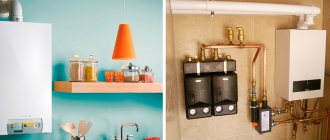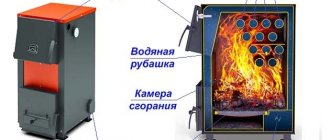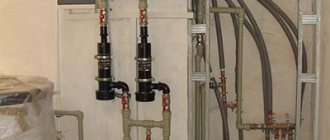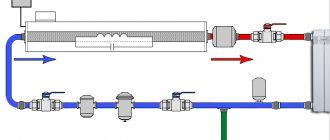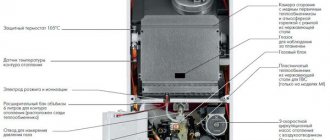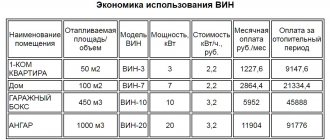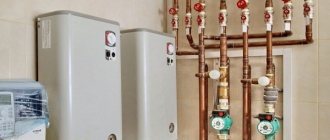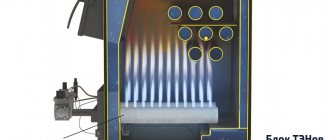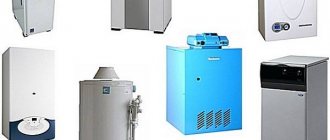Autonomous heating systems for private houses or other premises are usually built on the basis of gas boilers.
This is the most economical and effective heating method, which does not take extra time and effort from the owner and does not require him to constantly monitor the operation of the system.
There are two main design options for such boilers, the difference between which lies in functionality.
Some work only to heat the house, others are capable of supplying hot water in parallel with heating.
These two groups are represented by single- and double-circuit units, respectively, which need to be considered in more detail.
What is the difference between double-circuit and single-circuit boilers
The fundamental difference between single- and double-circuit boilers is the functionality of the units.
If the first group of equipment is intended only for supplying coolant to the heating circuit, then the second, in addition to heating the house, performs an additional task - preparing hot water for domestic needs.
As the name suggests, dual-circuit models have an additional circuit designed to heat water. At the same time, the main (basic) function for both groups of boilers is heating the coolant for the heating system.
It is provided by the main structural components - a gas burner and a primary heat exchanger, which is built into the heating circuit together with a circulation pump.
IMPORTANT!
Non-volatile boilers do not have a circulation pump and are designed for operation in systems with natural circulation.
The hot water heating function is additional - it is provided due to the partial transfer of thermal energy from the hot coolant, which, at the outlet of the main heat exchanger, enters the secondary, plate type.
It heats water in flow-through mode, which creates some restrictions on consumption - the more water is drawn, the less time the water flow has to heat up.
Some models can be configured to prioritize one or another circuit, when, with active consumption of hot water, the temperature in the heating system decreases or, conversely, the DHW temperature drops.
To solve the problem of efficient distribution of thermal energy between two circuits, a combined, or bithermic, heat exchanger was created. It is a coil coiled from a coaxial pipe.
The outer volume is occupied by coolant, and the inner volume is occupied by hot water. Heating occurs simultaneously, and there are no heat transfer losses. the efficiency of such a device is much higher.
However, experts speak with reserve about bithermal heat exchangers, since they quickly fill up from the inside with lime deposits, which are extremely difficult to remove.
Flushing such a heat exchanger is a labor-intensive and ineffective procedure, and replacement costs too much money.
This significantly limits the demand for models with a combined heat exchanger, although no one denies the increased efficiency of these units.
To more clearly display the difference between the design of single- and double-circuit boilers, let’s create a table:
| Features and Features | Single-circuit | Dual-circuit |
| Coolant heating | + | + |
| Preparing DHW | — | + |
| Number of heat exchangers | 1 | 2 or 1* |
| Possibility of cascade connection | + | — |
| Unit power limitations | — | + |
| Thermal energy losses | Minor | Average |
*for double-circuit boilers with bithermic heat exchanger
Single-circuit boilers
A single-circuit boiler is an installation that provides heating and preparation of the heating circuit coolant in accordance with the specified operating mode of the system.
The design includes:
- Gas burner combined with a heat exchanger.
- Circulation pump.
- Turbofan.
- Gas equipment.
- Three way valve.
- Electronic control board equipped with a self-diagnosis sensor system.
- Housing, control panel.
- Chimney.
There are non-volatile models that do not have devices powered from the mains.
They have a simplified design, but are able to provide heating for the house in the absence of power supply.
Types of single-circuit boilers
There are single-circuit boilers:
- Floor-standing . Installed directly on the floor (or on a stand). They can have a lot of weight and, accordingly, high power. Many floor-standing boilers are equipped with a cast iron heat exchanger of increased efficiency and heavy weight. Some models are connected in a cascade, forming powerful connections for heating buildings or structures of large area and volume.
- Wall mounted . Compact gas boilers that are mounted on solid (preferably load-bearing) walls. The specifics of the installation require a weight limit, which automatically affects the power of the boilers.
In addition, single-circuit boilers can have different combustion chamber options:
- Atmospheric (open) . The air comes directly from the room, and the smoke is removed naturally under the influence of stove-type draft.
- Turbocharged (closed) . Air is taken in from the outside using a turbofan. It also creates pressure that displaces smoke and other gases formed during fuel combustion.
All single-circuit boilers can have additional functions - remote control, programming of operating modes, etc.
Principle of operation
The operation of a single-circuit boiler is aimed at solving a single task - heating the coolant for the heating circuit.
The unit is connected to a gap in the system, one pipe is connected to the direct line, the second to the return line. The liquid flow continuously moves through a heat exchanger, which is located in the heating zone of the gas burner flame.
At the outlet of the heat exchanger, the flow enters a three-way valve, where it is mixed in a given proportion with the colder flow from the return. Having received the required temperature, the coolant is again discharged into the heating circuit.
The temperature is adjusted by adjusting the operation of the three-way valve.
NOTE!
Non-volatile models work on the same principle, only flow circulation occurs naturally.
Advantages and disadvantages
The advantages of single-circuit boilers include:
- Simplicity and reliability of design.
- No power loss during heat transfer.
- Ability to develop greater power.
- Possibility of connecting an external indirect heating boiler to produce hot water.
- The cost of single-circuit boilers is lower than that of more functional models.
The disadvantages of single-circuit boilers should be considered:
- Lack of water heating function.
- Limited capabilities compared to dual-circuit models.
IMPORTANT!
Some users claim that single-circuit boilers in conjunction with an external storage tank are much more convenient and efficient than double-circuit designs.
Classification
According to accepted terminology, a gas boiler can be:
- Floor or wall. One is installed only on the floor, the other is hung on the wall.
- Traditional (convection) and condensation type. The first does not use the entire combustion temperature of the gas, the second uses almost all of it due to the economizer.
- Single-circuit and double-circuit.
- With an open or closed combustion chamber.
- With electronic and pyroignition. The first ones start automatically, and the second ones by pressing the start button.
A floor-standing double-circuit or single-circuit boiler is popular. Such a unit provides opportunities in terms of choosing the required power and has a longer service life than a wall-mounted device. Floor-standing lasts up to 20-30 years, while wall-mounted only lasts up to 10-12 years.
But there is no reason to install such a unit in a small apartment. In addition to excessive power, it requires a special room, which is difficult to find in our multi-story buildings. This is an ideal solution for large private houses. In contrast, a wall-mounted device is installed in the kitchen or loggia. It doesn't matter if it's single-circuit or double-circuit.
It's compact, costs less, and is easy to install, although installation is best left to a professional. Wall-mounted boiler of different shapes, which facilitates the design task - matching to the interior.
Floor standing boiler
Therefore, such a boiler is more suitable for apartments.
A traditional type boiler, single-circuit and double-circuit, is less productive than a condensing boiler. The efficiency is lower, since in condensation the heat contained in the exhaust gases and water vapor is not used to heat the street. The cost of such equipment is higher. Although manufacturers claim that the difference pays off in 2-4 years due to heat savings, the demand for them is not so high.
Demand largely depends on the functionality of the boiler. And this is directly related to the number of circuits. To ensure both heating of the apartment and supply of hot water, the installation of an additional boiler is required - an indirect heating boiler. A double-circuit boiler copes with the tasks without additional difficulties.
Double-circuit boilers
Double-circuit boilers have an additional option - DHW preparation.
At the same time, the basic function (heating of the coolant) is the main one; the operating settings set the priority of heating over DHW.
Kinds
According to the installation method, double-circuit boilers can be::
- Floor-standing . Installed directly on the floor.
- Wall mounted . Hanged on a load-bearing wall.
By heat transfer method:
- Convection . The usual method of heating is in a burner flame.
- Condensation . Two-stage heating - first preheating from thermal energy obtained by condensing moisture from flue gases. Then normal heating is carried out using a gas burner. Since the coolant has already been prepared, it is possible to reduce gas consumption and the overall heating mode without reducing the final result.
By heat exchanger type:
- Separate . Two heat exchangers operate - primary (heating the coolant) and secondary (heating the hot water from the hot coolant).
- Combined (bithermic) . A coaxial type of heat exchanger is used, in which both the coolant and hot water are simultaneously prepared.
By type of combustion chamber:
- Atmospheric.
- Turbocharged.
The designs of single- and double-circuit boilers have no fundamental differences, but are intended to operate under different conditions.
Principle of operation
The operation of a double-circuit boiler differs from single-circuit designs only in the presence of an additional heat exchanger.
At the exit from the primary, the coolant enters the secondary heat exchanger, where it heats water for hot water supply . The rest of the work is no different and follows the standard pattern.
Advantages and disadvantages
The advantages of double-circuit boilers include:
- The ability to receive both heat and hot water from one device.
- Efficient, economical and compact.
- Wide range of functions and capabilities.
- You can turn off DHW heating if not in use.
Disadvantages can be considered:
- Limited amount of hot water.
- Dependence of temperature in the heating circuit on the intensity of hot water collection.
Double-circuit boilers are considered more attractive, capable of solving all issues.
Which boiler should you choose?
The choice of one type of gas boiler or another is determined by working conditions and people’s needs.
When deciding which boiler is more suitable in a given situation, it is recommended to consider all the criteria:
Dimensions
The size of a gas boiler is not determined by its functionality. Most often, in one model line, all units are produced in the same standard housing size .
Wall-mounted boilers are more compact, but the main factors influencing the size are the power and performance of the units.
Life time
The duration of operation of gas boilers is determined by operating conditions, loads and power levels.
In addition, an important indicator is the quality of water - the appearance of scale quickly damages the heat exchanger . This applies equally to single- and double-circuit boilers.
Saving
Users note some advantages of single-circuit boilers in terms of gas consumption. This affects fuel payments . At the same time, if an external boiler is connected, gas consumption increases.
Convenience
In terms of ease of use, double-circuit boilers definitely win. They do not require the installation of additional water heaters, which greatly simplifies the creation of communications .
Single-circuit models are convenient only where you only need to heat the room, but such situations are rare.
Price
The cost of both boilers mainly depends on the power and other parameters of the boiler.
However, if we compare a single- and double-circuit model with the same characteristics, then a single-circuit boiler will be cheaper.
Heating area
The heating area of the boiler depends on its power. It is taken into account at the rate of 1 kW of power = 10 m2 .
In this case there is no dependence on the set of functions; the ratio is equally valid for both types of units.
Additional functions
Dual-circuit models are usually equipped with additional functions. There is remote control, programming, and the ability to connect a room thermostat.
Single-circuit boilers are simpler and less equipped with additional devices due to lack of demand.
Conclusion - which boiler is better?
It is impossible to say unequivocally which boiler is better. We must be guided by the needs and objectives of the premises, consider the number of people, lifestyle and other factors.
Both types of boilers may or may not be necessary in different situations..
In order to name a suitable option, you need to consider all the influencing factors, and only then make a decision.
How to choose an indirect heating boiler
Making the right choice of the appropriate indirect heating boiler model is a difficult task for a beginner. However, there is nothing overwhelming here, you just need to take into account a few important nuances:
When choosing an indirectly heated water heater for an apartment or private house, the first step is to determine the optimal volume of the storage tank. To ensure that there is enough hot water for all family members, it is calculated taking into account the approximate consumption of 100 liters per day by one person. An indirect water heating boiler is economically beneficial for a family of four or more people
With this number of people, the approximate DHW consumption is 1.5 l/min. Paying attention to the volume of the tank, take into account the heating time. A larger container will take longer to heat up. It may be worth giving preference to a model with two heat exchangers or a tank-in-tank system. The composition of the thermal insulation determines how long the water will remain hot after the boiler is turned off.
Cheap water heaters come with foam rubber. The porous material retains heat poorly and quickly decomposes. The optimal thermal insulation is mineral wool or polyethylene foam. To make the right choice, you need to compare the power of the indirect water heater and the heating boiler. If the latter is characterized by weak parameters, the boiler will become an unbearable load. When buying any model, be sure to pay attention to the presence of a thermostat, valve and other safety elements.
It may be worth giving preference to a model with two heat exchangers or a tank-in-tank system. The composition of the thermal insulation determines how long the water will remain hot after the boiler is turned off. Cheap water heaters come with foam rubber. The porous material retains heat poorly and quickly decomposes. The optimal thermal insulation is mineral wool or polyethylene foam. To make the right choice, you need to compare the power of the indirect water heater and the heating boiler
If the latter is characterized by weak parameters, the boiler will become an unbearable load. When buying any model, be sure to pay attention to the presence of a thermostat, valve and other safety elements.
When all the important nuances have been resolved, you can pay attention to the form, design, manufacturer and other details
Calculation of storage tank volume
To make an approximate calculation of the volume of the storage tank, you can use a simple reading of the water meter. When the same number of people constantly arrive in a house, the daily consumption will have the same data.
A more accurate calculation of volume is based on counting water points, taking into account their purpose and the number of living family members. In order not to go into complex formulas, hot water consumption is taken from the table.
